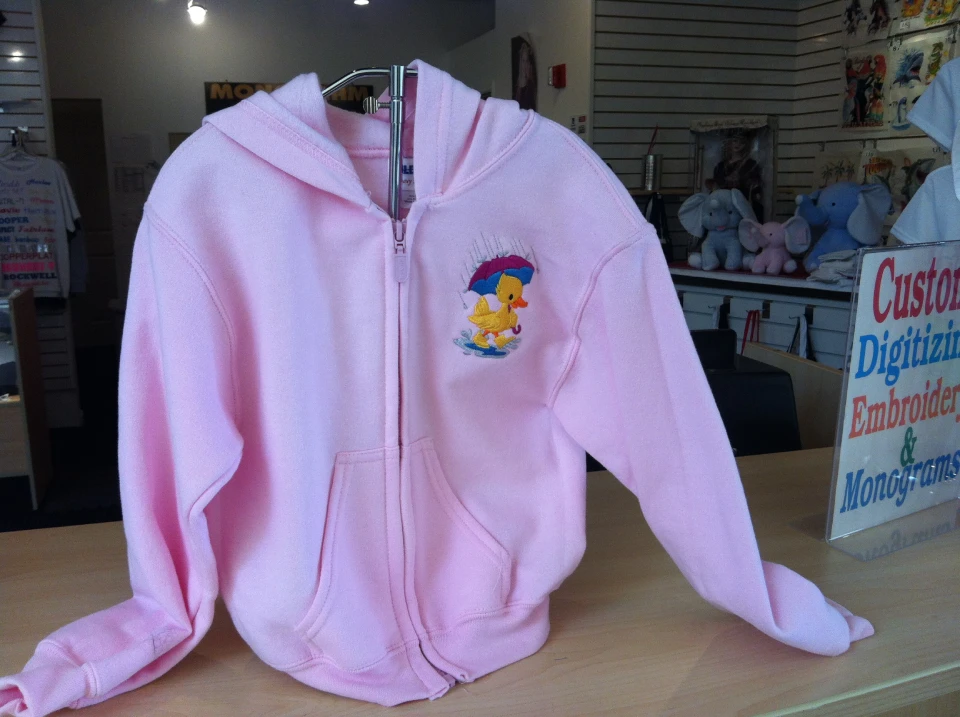Classy Monogramming on Towels for a Touch of Luxury
Wiki Article
The Art of Customized Needlework: Unlocking the Keys to Creating Unique and Unforgettable Designs
The secrets to developing custom-made embroidery designs that astound the eye and leave a long lasting impact lie in a fragile balance of technique, creative thinking, and interest to detail. As we dive right into the world of personalized needlework, we discover the nuanced interplay in between thread selection, sew complexity, and style personalization that boosts a simple garment to a job of art.Selecting the Right Embroidery Threads
When selecting embroidery strings, what vital factors should you think about to make certain the most effective results for your custom-made layouts? The choice of embroidery thread is critical in determining the final result of your stitched layout. Among the primary considerations is the material of the thread. Various products such as cotton, polyester, rayon, and silk offer varying levels of sheen, toughness, and appearance. It is vital to select a thread material that matches the material you are embroidering on and lines up with the wanted look of the style.
Thicker strings can include dimension and texture to your layout, while finer threads are excellent for complex details and tiny text. Furthermore, considering the color fastness and washability of the thread is vital to guarantee that your custom styles maintain their quality and vibrancy over time.
Discovering Different Stitch Strategies
To explore the world of 'Exploring Different Stitch Techniques', one have to understand the intricacies and nuances that each sewing method gives the art of needlework. Different stitch methods not just add visual passion but additionally add to the general structure and measurement of the layout. One prominent stitch strategy is the satin stitch, which involves carefully stuffed parallel stitches to create a smooth and shiny surface area, ideal for filling out shapes and developing vibrant describes.On the various other hand, the backstitch is a functional technique typically made use of for outlining and including great details. It includes sewing in reverse to develop a strong line of embroidery. Additionally, the French knot stitch adds a tactile aspect to styles, best for producing textured accents like flower centers or decorative touches.
Exploring different stitch methods enables embroiderers to have fun with light, darkness, and depth within their styles, raising the visual appeal and creative high quality of their embroidery jobs. By grasping different stitching methods, one can unlock unlimited opportunities for developing unique and memorable customized needlework pieces.
Incorporating Personalized Design Elements
Having explored the details of different stitch techniques such as the satin stitch, backstitch, and French knot, the emphasis now changes in the direction of incorporating tailored style aspects in customized embroidery jobs. Customized style elements play an essential function in making needlework jobs really unique and remarkable.An additional method to incorporate tailored style elements is by consisting of symbols or themes that hold unique significance to the recipient or mirror their interests important link and individuality. For instance, including see page a favorite flower, animal, or hobby-related icon can make the embroidery style more significant and tailored. Additionally, selecting shades that resonate with the recipient or align with the designated motif can further improve the customization of the needlework task.
Mastering the Art of Shade Control

One secret facet of shade coordination is comprehending shade concept. This consists of knowing exactly how various shades connect with each other, the feelings they convey, and just how they can be integrated to develop visually attractive layouts. By applying color concept concepts, embroiderers can develop harmonious color schemes that boost the total appearance of the layout.
In addition, paying interest to comparison is essential in color coordination. Making use of contrasting colors can aid particular elements of the design pop, enhance clarity, and develop an aesthetically vibrant needlework piece. By mastering the art of color sychronisation, embroiderers can boost their layouts and produce unforgettable items that reverberate with customers and customers alike.
Enhancing Appearance With Advanced Needlework Stitches
French knots, for instance, are best for including tiny, elevated dots to your layout, mimicking the look of beads or creating a textured surface. Bullion knots, on the other hand, can be used to create twisted, ropelike elements that add a lavish feel to the needlework. Seed sewing includes small, scattered stitches that can fill out locations with a multicolor structure, while turkey work creates fluffy, dimensional accents reminiscent of animal hair or vegetation. Try out these innovative needlework stitches enables you to push the limits of conventional embroidery and create absolutely one-of-a-kind and aesthetically attractive structures in your designs.
Conclusion
In conclusion, the art of personalized embroidery involves a mix of selecting the right strings, exploring numerous stitch methods, incorporating personalized layout aspects, mastering shade sychronisation, and enhancing appearance with sophisticated stitches. By recognizing and carrying out these key components, embroiderers can create one-of-a-kind and unforgettable layouts that showcase their creative thinking and skill. Needlework enthusiasts can open the keys to producing gorgeous and custom pieces that stick out and leave a lasting perception.Report this wiki page